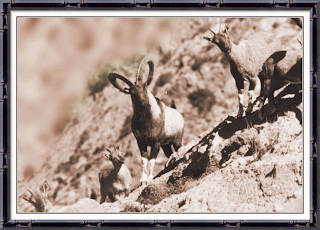Lahndi, also known as dried meat, is a winter food popular in Afghanistan and the Pashtun belt of Pakistan, situated across the Durand Line. Consumption of lahndi is common during the winter months. Sheep are specially fattened so that their flesh may be more suitable for preparing lahndi.
METHOD:
Lahndi is usually prepared from lamb and sheep, although it can also be made from beef. It is prepared as follows. First a lamb or sheep is slaughtered in the Islamic way, i.e. halal. Then the wool is separated in a proper and skilled way, leaving only the skin. After that, the remaining hairs on the skin are burned away with fire, after which the meat is wiped to get rid of the carbon deposits. Then the meat is cut into smaller pieces and rubbed with salt to avoid bacteria. It is also rubbed with pungent-smelling asafoetida, which is a little like garlic and serves as a preservative, a much-needed additive in a part of the world where electricity and refrigerators are rare.After preparation, the meat is strung on lahndi poles.
The best time to prepare lahndi is December, when the meat dries out within fifteen days if it is cold enough. It is commonly eaten in winter to keep a person warm and help him face the extreme weather. Sheep are specially fattened so that they may be more suitible for preparing "landhi" Air-dried salted meat is a feature of Afghan cuisine developed by Afghans.
How to cook Lahndi Paluo:
Several dishes can be prepared by using Lahndi meat.The meat must be salted and exposed to air at least a couple of days before cooking.
1/2 lb. landi
3 c. rice
1/3 c. oil
1/2 tsp. tumeric
1 1/2 c. dried orange peel
2 tsp. minced fresh garlic
1/2 c. dried mint
3 medium onions
2 tsp. salt
1/4 tsp. red pepper
8 c. water for rice
6 c. water for meat
Wash landi meat with warm water and place into pot with 6 c. water. let it boil for 1 hour over medium heat and take off all foam from the top of the water. Check meat for done. If it is not tender, let it boil for another 1/2 hour.
Fry chopped onions with 1/2 c. oil until brown. Remove meat from pot and set into onion pot. Add 1 c. water, stirring until onions dissolve. Set aside.
Wash rice and soak it in the water for 45 minutes. Boil water in a separate pot. Drain rice into a colander, then place it into meat mixture, and keep stirring. Add 2 c. water and salt. Cover with lid, then cook for 2 minutes.
remove the lid and add garlic, tumeric, orange peel, and red pepper. Heat remainder of oil, pour over rice with 1 c. warm water and cover like other dishes. Set on high heat for 2 minutes and over low heat for 40 minutes
























































